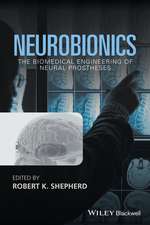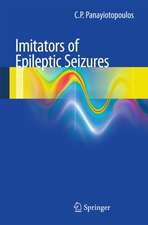Brainstem Disorders
Editat de Peter P. Urban, Louis R Caplanen Limba Engleză Hardback – 26 iul 2011
| Toate formatele și edițiile | Preț | Express |
|---|---|---|
| Paperback (1) | 732.92 lei 6-8 săpt. | |
| Springer Berlin, Heidelberg – 23 aug 2016 | 732.92 lei 6-8 săpt. | |
| Hardback (1) | 1064.62 lei 3-5 săpt. | |
| Springer Berlin, Heidelberg – 26 iul 2011 | 1064.62 lei 3-5 săpt. |
Preț: 1064.62 lei
Preț vechi: 1120.64 lei
-5% Nou
Puncte Express: 1597
Preț estimativ în valută:
203.74€ • 211.92$ • 168.20£
203.74€ • 211.92$ • 168.20£
Carte disponibilă
Livrare economică 24 martie-07 aprilie
Preluare comenzi: 021 569.72.76
Specificații
ISBN-13: 9783642042027
ISBN-10: 3642042023
Pagini: 350
Ilustrații: XII, 363 p.
Dimensiuni: 210 x 279 x 21 mm
Greutate: 1.25 kg
Ediția:2011
Editura: Springer Berlin, Heidelberg
Colecția Springer
Locul publicării:Berlin, Heidelberg, Germany
ISBN-10: 3642042023
Pagini: 350
Ilustrații: XII, 363 p.
Dimensiuni: 210 x 279 x 21 mm
Greutate: 1.25 kg
Ediția:2011
Editura: Springer Berlin, Heidelberg
Colecția Springer
Locul publicării:Berlin, Heidelberg, Germany
Public țintă
Professional/practitionerCuprins
Part I: Neuroanatomy of the brainstemPart II: Diagnosistic imaging and interventional treatment of brainstem lesions:Neuroradiology.-Ultrasound Diagnosis.-Blinkreflex.-Masseter Reflex.-Early Acoustic Evoked Potentials.-Somatosensory Evoked Potentials.-Transcranial magnetic stimulation.-Laser evoked potentials.-Recording of eye movements.-Other electrophysiologic methods for the investigation of brainstem reflexes.Part III: Diagnostic Findings:Disorders of ocular motility.-Horner’s syndrome.-Central vestibular disturbances.-Tinnitus and auditory disturbances.-Intra-axial cranial nerve lesions.-Speech disorders.-Dysphagia.-Ataxia.-Pareses.-Sensory disturbances.-Bladder disturbances.-Drop attacks.-Respiratory disturbances.-Disturbances of consciousness.-Brain death diagnosis in primary brainstem injury.-Clinical brainstem reflexes.-Rare Findings/Symptomes.Part IV: Diseases: Vascular brainstem diseases.-Intraparenchymatous brainstem hemorrhage.-Perimesencephalic subarachnoid hemorrhage and cerebral superficial siderosis.-Vascular malformation.-Basilar migraine / vestibular migraine.-Inflammations of the brainstem.-Brainstem involvement in demyelinating diseases.-Paraneoplastic brainstem syndromes.-Brainstem tumors.-Traumatic Brainstem Lesions.-Degenerative brainstem disorders.-Abnormalities of brainstem development.-Metabolic brainstem diseases.-Vascular cranial nerve and brainstem compressions.
Recenzii
From the reviews:
“This monograph predominantly written by German authors is an excellent review of the brain stem and its disorders. … The text is profusely littered with tables, diagrams and images making it an excellent learning tool. … This is … a superb contribution to the literature and its multidisciplinary, integrated approach combining anatomical, physiological, pathological and imaging detail means that it would be profitably read not only by radiologists with an interest in the brain but also by neurologists and other interested stroke physicians.” (Arpan Banerjee, RAD Magazine, November, 2011)
“This monograph predominantly written by German authors is an excellent review of the brain stem and its disorders. … The text is profusely littered with tables, diagrams and images making it an excellent learning tool. … This is … a superb contribution to the literature and its multidisciplinary, integrated approach combining anatomical, physiological, pathological and imaging detail means that it would be profitably read not only by radiologists with an interest in the brain but also by neurologists and other interested stroke physicians.” (Arpan Banerjee, RAD Magazine, November, 2011)
Notă biografică
Prof. Dr. med. Peter Paul Urban, M.A., is Professor of Neurology. He received his medical degree and his medical training at the University of Mainz. He graduated in 1988 ‘summa cum laude’ (doctoral thesis). After his medical internship at the Department of Cardiology (1988 to 1990) he continued as a resident at the Department of Neurology, University of Mainz. After board certification in 1997 he worked as a consultant at the Department of Neurology, University of Mainz and was senior lecturer after his habilitation (2000). In 2006 he was appointed as head of the Department of Neurology, Asklepios Klinik Barmbek, Hamburg, and was made Professor of Neurology at the University of Hamburg in 2007. From 2001 to 2002 he pursued a course of studies in health economics at the Universities of Kaiserslautern and Witten/Herdecke and was awarded the degree Master of Arts (M.A.). He holds board certification for EEG, EMG, EP and Doppler of the German Society of Clinical Neurophysiology and a board certificate for 'special neurological intensive care medicine'.
Prof. Urban received ten scientific awards including the Richard-Jung-Award of the German Society of Clinical Neurophysiology (1999), the Boehringer-Ingelheim-Award (2001), and the Scientific Award of the European Neurological Society (2004).
He has published more than 100 original papers, 47 book chapters and a book on brainstem diseases. His fields of research comprise cerebrovascular disorders, especially of the brainstem, clinical neurophysiology and movement disorders. He is a member of several scientific organizations including the American Academy of Neurology, the Movement Disorders Society, and the German Society of Neurology.
Professor Louis Robert Caplan obtained his medical degree from the University of Maryland School of Medicine. From 1970 to 1978 he was Assistant Professor of Neurology at Harvard Medical School and in 1979 became Neurologist-in chief at theMichael Reese Hospital and Professor of Neurology University of Chicago. From 1985-1997, he was Neurologist-in-Chief at the new England Medical Center and was Professor and Chair of Neurology at Tufts University School of Medicine. In 1999, he became Professor of Neurology at Harvard Medical School. Professor Caplan is a member of many medical societies, including the American Heart Association for which he has served on the science advisory, and nominating committees and was Chairman of the Stroke Council from 1986-1989. He has received many awards and honours, and is an honorary member of several neurological societies. As a member of the steering committee, data and safety committee, or executive committee, Professor Caplan has been involved in many neurological clinical trials, and is a member of several advisory boards. Professor Caplan has been or is currently on the editorial board of journals such as Stroke, Neurology, Clinical Neuropharmacology, Cerebrovascular Diseases (Associate Editor), Headache, Brain, European Neurology (Associate Editor), Archives of Neurology, The Neurologist, Journal of Neurology, Neurosurgery & Psychiatry (International Editor for North America), Current Neurology and Neuroscience Reports, Reviews in Neurological Disease (Co-Editor), and the Journal of Clinical Neurology. As author and co-author, he has published 37 books and monographs, 197 original reports, 26 proceedings of meetings, 483 clinical reviews, observations and educational studies, and 92 abstracts.
Prof. Urban received ten scientific awards including the Richard-Jung-Award of the German Society of Clinical Neurophysiology (1999), the Boehringer-Ingelheim-Award (2001), and the Scientific Award of the European Neurological Society (2004).
He has published more than 100 original papers, 47 book chapters and a book on brainstem diseases. His fields of research comprise cerebrovascular disorders, especially of the brainstem, clinical neurophysiology and movement disorders. He is a member of several scientific organizations including the American Academy of Neurology, the Movement Disorders Society, and the German Society of Neurology.
Professor Louis Robert Caplan obtained his medical degree from the University of Maryland School of Medicine. From 1970 to 1978 he was Assistant Professor of Neurology at Harvard Medical School and in 1979 became Neurologist-in chief at theMichael Reese Hospital and Professor of Neurology University of Chicago. From 1985-1997, he was Neurologist-in-Chief at the new England Medical Center and was Professor and Chair of Neurology at Tufts University School of Medicine. In 1999, he became Professor of Neurology at Harvard Medical School. Professor Caplan is a member of many medical societies, including the American Heart Association for which he has served on the science advisory, and nominating committees and was Chairman of the Stroke Council from 1986-1989. He has received many awards and honours, and is an honorary member of several neurological societies. As a member of the steering committee, data and safety committee, or executive committee, Professor Caplan has been involved in many neurological clinical trials, and is a member of several advisory boards. Professor Caplan has been or is currently on the editorial board of journals such as Stroke, Neurology, Clinical Neuropharmacology, Cerebrovascular Diseases (Associate Editor), Headache, Brain, European Neurology (Associate Editor), Archives of Neurology, The Neurologist, Journal of Neurology, Neurosurgery & Psychiatry (International Editor for North America), Current Neurology and Neuroscience Reports, Reviews in Neurological Disease (Co-Editor), and the Journal of Clinical Neurology. As author and co-author, he has published 37 books and monographs, 197 original reports, 26 proceedings of meetings, 483 clinical reviews, observations and educational studies, and 92 abstracts.
Textul de pe ultima copertă
The brainstem includes numerous pathways connecting different brain areas and the spinal cord, neural networks with coordinating tasks, and brainstem nuclei. Consequently its topography is complex, and even experienced neurologists find it challenging to localize brainstem lesions and diagnose brainstem disorders. This richly illustrated book provides a comprehensive review of brainstem disorders and presents the relevant clinical knowledge necessary for diagnosis. The opening sections document the brainstem neuroanatomy and discuss current diagnostic methods. The entire spectrum of clinical findings in brainstem disorders is then described, and topodiagnostic aspects of the neurological findings are explained in detail. The descriptions of brain stem disorders are consistently structured and are supported by many MR images and short case reports. In addition to primary brainstem lesions, such as vascular brainstem syndromes, other disorders are considered that do not exclusively show brainstem symptoms or signs, e.g., multiple sclerosis. This book will serve as an invaluable reference work for neurologists in clinical practice or further education.
Caracteristici
A comprehensive review of brainstem disorders that presents the clinical knowledge necessary for diagnosis Documents the brainstem neuroanatomy and discusses current diagnostic methods Describes the entire spectrum of clinical findings in the various brainstem disorders and explains in detail the topodiagnostic aspects of neurological findings Includes many MR images and short case reports Includes supplementary material: sn.pub/extras













